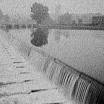| Date | Text | |
|---|---|---|
30 Sep 1882

The first U.S. hydroelectric power plant |
The first U.S. hydroelectric power plant In 1882, the world's first hydroelectric power plant in the U.S. was opened on the Fox River, in Appleton, Wisc. Powered by a water wheel, a single dynamo provided 12.5 kilowatts enough for 180 lights, of ten candlepower each. Appleton paper manufacturer H.F. Rogers, had been inspired by Thomas Edison's plans for a steam-powered electricity production station in New York. He had financial support from a personal friend of Edison's and two other men, all from Appleton. Rogers began building the power plant at his riverside paper mill during the summer of 1882. Later known as the Appleton Edison Light Company, it produced produced enough electricity to light Rogers' home, the plant itself, and a nearby building. |
|
30 Sep 1882

Charles Lawrance |
birth Charles Lawrance Born 30 Sep 1882; died 24 Jun 1950 at age 67. Charles Lanier Lawrance was an American aeronautical engineer who designed the first successful air-cooled aircraft engine, used on many historic early flights. He also designed a new type of wing section with an exceptionally good lift-to-drag ratio. His wing design was used widely in World War I. By the mid-1920s his improvements in engine power and reliability made a remarkable series of long-distance flights possible, including those of Admiral Byrd, Charles Lindbergh, Amelia Earhart and Clarence Chamberlin. Despite the sensational publicity of the Lindbergh flight, Lawrance remained in relative obscurity - upon which he commented, "Who remembers Paul Revere's horse?" For his J-5 Whirlwind engine, Lawrance was awarded the annual Collier Trophy in 1928. |
|
30 Sep 1882

Hans Geiger |
birth Hans Geiger Born 30 Sep 1882; died 24 Sep 1945 at age 62. Hans Wilhelm Geiger was a German physicist who introduced the Geiger counter, the first successful detector of individual alpha particles and other ionizing radiations. After earning his Ph.D. at the University of Erlangen in 1906, he collaborated at the University of Manchester with Ernest Rutherford. He used the first version of his particle counter, and other detectors, in experiments that led to the identification of the alpha particle as the nucleus of the helium atom and to Rutherford's statement (1912) that the nucleus occupies a very small volume in the atom. The Geiger-Müller counter (developed with Walther Müller) had improved durability, performance and sensitivity to detect not only alpha particles but also beta particles (electrons) and ionizing electromagnetic photons. Geiger returned to Germany in 1912 and continued to investigate cosmic rays, artificial radioactivity, and nuclear fission. |
|
30 Sep 1882

Johannes Hans Geiger |
birth Johannes Hans Geiger Johannes Hans Geiger (died 1945), inventor of the Geiger counter. |